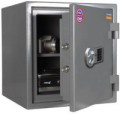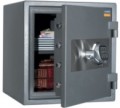Capacity
The volume of the interior space of the safe. Usually this parameter is indicated taking into account the safe-in-safe and other additional internal compartments. The amount of content that can be placed inside directly depends on the volume; on the other hand, it affects the external dimensions and weight of the storage.
Fire resistance class
The rate of resistance of the safe to high temperatures. You should pay attention to this parameter when choosing a safe for storing documents or electronic media that are sensitive to high temperatures.
Fire resistance classes for safes are usually specified in accordance with the ESC-B EN 15569 and GOST R 50862-2005 standards. The first implies a division into two classes (LFS 30P and 60P), the second fundamental document has a broader class and identifies three categories of fireproof safes:
- B. At an external temperature of 1100 °C, the temperature inside the storage should not exceed 170 °C. This is enough to protect paper documents.
- D. At the same 1100 °C outside, the temperature limit inside is 70 °C. This is already enough to protect hard magnetic disks, magnetic film and film.
— DIS. The maximum temperature inside such safes at 1100 °C outside is 50 °C. This allows them to be used even for floppy disks.
Each category consists of 4 classes, denoted by the numbers 30, 60, 90 or 120, for example 60B or 120D. The figure means the time (in minutes) the temperature inside the safe will remain within the parameters specified by the category while outer temperature is 1100 °C: for example, the first corresponds to the protection of paper from fire for an hour, the second – to the protection of film for two hours.
Nowadays, the most popular fire resistance classes on the market are:
30 min,
60 min..., 90 min, 120 min.Number of locking bolts
The number of locking bolts provided in the design of a standard safe lock.
The locking bolt is a working element of the lock, which responds directly to the locking. It is a rod, disk, or other element (usually metal) that fits into a slot in the fixed part of the safe, blocking the opening of the door. The more such elements a safe has, the more reliable the lock and the lower the probability of opening the door by “brute force”.
This parameter in our catalog is indicated for one lock, regardless of their number in a safe. Most often, all safe locks have the same number of bolts.
Now on the market there are locks with the following number of locking bolts:
2,
3,
4,
5,
6 and
more.
External dimensions (HxWxD)
The size of safe regarding its external dimensions. These figures will allow you to estimate how much space the safe takes up and whether it will fit into the intended installation location. Of course, greater capacity implies larger dimensions.
Internal dimensions (HxWxD)
Dimensions of the interior space of the safe. Note that in our catalog this parameter is indicated without a safe-in-safe, ammo compartment (see below) or other additional compartment provided inside.
This parameter directly determines the internal volume (see below). In addition, with the internal dimensions are known, you can determine whether this or that object will fit inside; this is especially important if you plan to use the safe for large items (for example, large-format documents that cannot be folded) — after all, in different models, the dimensions on three sides can vary significantly even with the same capacity.
Door thickness
This parameter means the actual thickness of the safe door; do not confuse it with wall thickness, see below. This dimension is measured excluding the lock and other protruding parts. It is one of the main factors determining the reliability and burglary resistance of a safe (see “Burglary resistance class”). In addition, regulatory documents may consist of direct requirements for certain categories of safes (for example, gun safes, "bank", etc.), including the minimum permissible door thickness.
Note that a thick door is especially important for embedded models (see "Product Type") — after all, in the normal position from the sides and back, the storage is protected by the wall it is mounted into, and the door remains outside.
Body thickness
The total thickness of the safe body, in other words, the thickness of the entire layer of material that separates the internal space of the safe from the environment. Do not confuse this parameter with the safe wall thickness (see below).
Most often, the dimensions of the walls are the same on the sides and back, so it is enough to indicate the general value in the specs. Anyway, the reliability and burglary resistance of a model, as well as its compliance with regulatory requirements, depend on this indicator — for certain areas of application (gun safes, bank safes, etc.), the terms of the legislation can be very detailed and prescribe even the lowest permissible body thickness.
Weight
The total weight of the empty safe. Unlike many other products, for safes, heavy weight is usually more of an advantage than a disadvantage: the heavier the safe, the more difficult it is to steal it entirely for later opening in a safe place. The only exceptions are portable and automotive models (see "Product Type") — in their case, theft prevention is ensured primarily by fastening, and in the first case, the product, by definition, must be suitable for carrying in hands.

